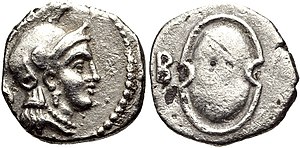This article includes a list of general references, but it lacks sufficient corresponding inline citations. (May 2017) |
Somatophylakes (Greek: Σωματοφύλακες; singular: somatophylax, σωματοφύλαξ) were the bodyguards of high-ranking people in ancient Greece.

The most famous body of somatophylakes were those of Philip II of Macedon and Alexander the Great. They consisted of seven men, drawn from the Macedonian nobility, who also acted as high-ranking military officers, holding command positions such as general or chiliarch. Alexander the Great appointed Peucestas as eighth somatophylax after the siege of Malli.
Under Alexander the Great
edit(Note that this list is speculative in several cases and would be disputed by scholars. For example, Hephaestion was probably not named as early as given below. The only complete list of Alexander's bodyguard in the original sources is found in Arrian (6.28.4), upon the extraordinary appointment of Peucestas in Carmania.)
- 336–334
- 333
- Aristonous, Lysimachus, Peithon, Arybbas, Balacrus, Demetrius, Hephaestion.
- 332
- Aristonous, Lysimachus, Peithon, Arybbas, Menes, Demetrius, Hephaestion.
- 331
- Aristonous, Lysimachus, Peithon, Leonnatus, Menes, Demetrius, Hephaestion.
- 330–327
- Aristonous, Lysimachus, Peithon, Leonnatus, Perdiccas, Ptolemy of Lagus, Hephaestion.
- 326–324
- Aristonous, Lysimachus, Peithon, Leonnatus, Perdiccas, Ptolemy of Lagus, Hephaestion, Peucestas.
- 323
- Aristonous, Lysimachus, Peithon, Leonnatus, Perdiccas, Ptolemy of Lagus, Peucestas.
Royal agema
editThe term somatophylakes is also used to refer to a member of the Royal Hypaspists, the agema, who acted as the King's bodyguard in battle. The Royal Pages would expect to begin their military service in this unit: thus Pausanias, Philip II's assassin was a member of this corps, not one of the Seven Bodyguards.
W Heckel[2] believes that the Ptolemy* given above for 336 BC was not one of the Seven but commander of this unit. He was killed at Halicarnassus in 334 BC and succeeded by Admetus. The latter was killed at Tyre in 332 BC and appears to have been succeeded by Hephaestion.
See also
editReferences
edit- Heckel, Waldemar. "The 'Somatophylakes' of Alexander the Great: Some Thoughts." Historia: Zeitschrift für Alte Geschichte Bd. 27, H. 1 (1st Qtr. 1978), pp. 224–228.
- ^ Rider, Georges Le (2007). Alexander the Great: Coinage, Finances, and Policy. American Philosophical Society. p. 153. ISBN 9780871692610.
- ^ 'Who's Who in the Age of Alexander the Great' p.262 and note 638
External links
edit- Somatophylax (Bodyguard) at Livius.org